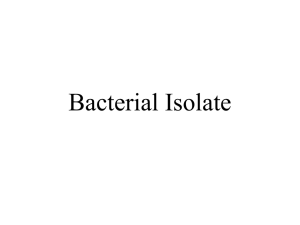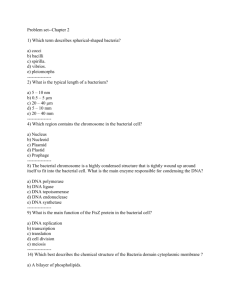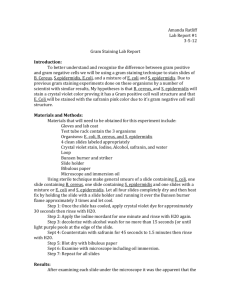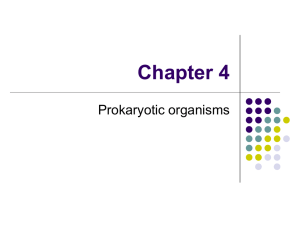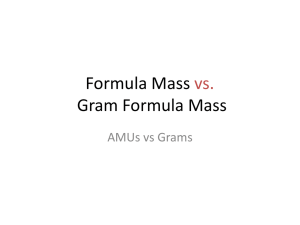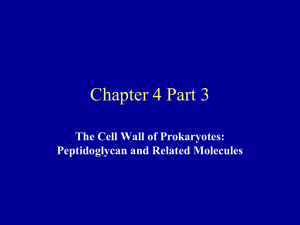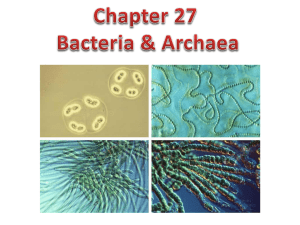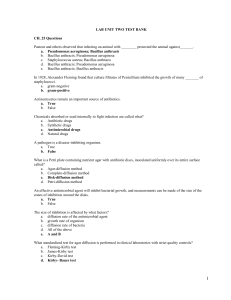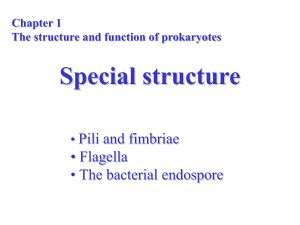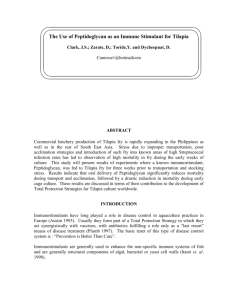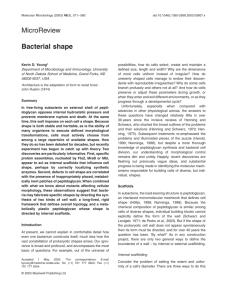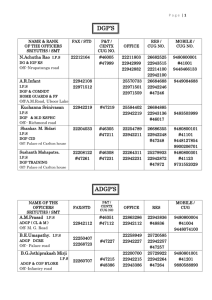Lecture 5 Classification (Ch.10,11)
advertisement
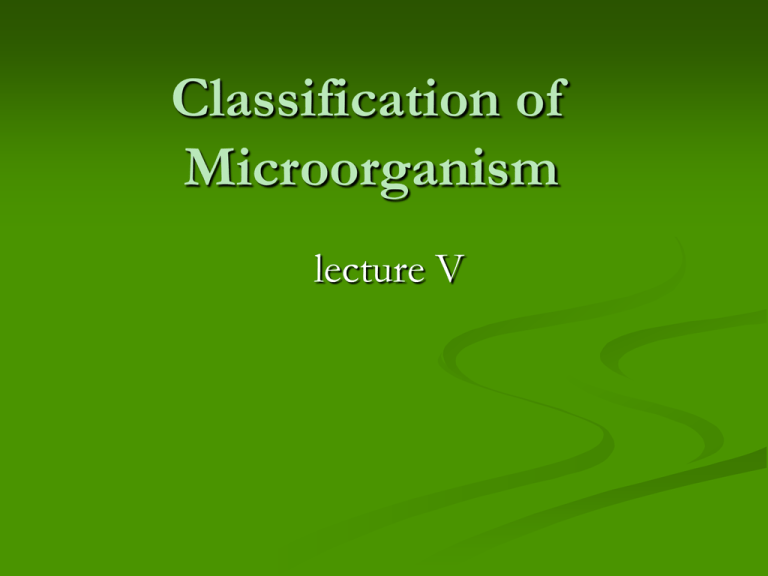
Classification of Microorganism lecture V Taxonomy (Greek) ---taxis to arrange, to order nomos law The science of classifying organisms Provides universal names for organisms Provides a reference for identifying organisms Species Definition Eukaryotic species: A group of closely related organisms that breed among themselves Species Definition Prokaryotic species: A population of cells with similar characteristics (same growth requirements etc.) Clone: Population of cells derived from a single cell (pure culture concept) Strain: Genetically different cells within a clone (E.coli 0157:H7) Species Definition Viral species: Population of viruses with similar characteristics (Enteroviruses—Polio,Coxsackie & Echovirus) that occupies a particular ecological niche (GI tract) Taxon (sn.) Taxa (pl.) Arrangement of organisms into taxonomic categories Reflect degree of evolutionary (phylogenetic) relatedness Classification history Aristotle Plants, or Animals Classification history (cont.) Edward Chatton (1937) Introduced the term procaryote Cells without nucleus Classification history (cont.) Robert H. Whittaker (1969) Five-Kingdom System Animals Plants Fungi Protista Procaryotes Five-Kingdom System (cont.) Based on physical description Nutritional requirements Patterns of development Type of flagella Five-Kingdom System Considers procaryotes (bacteria) the ancestors of all eucaryotes Kingdom Procaryotae (bacteria) Unicellular Asexual reproduction Flagella composed of flagellin Adsorptive nutrition Categories of procaryotes (bacteria) With cell wall Gram + and Gram Archaeobacteria Without cell wall Mycoplasma Gram negative Outer and inner membranes Thin peptidoglycan No endospore-forming Gram positive No outer membrane Thick peptidoglycan Some spore-forming Archaeobacteria Extreme environments Cell wall (no peptidoglycan) Share some genetic features with eucaryotes Bacteria without cell wall Mycoplasma Highly pleomorphic Very small Sterols (as eucaryotes) Kingdom Protista Mostly unicellular Multicellular lack tissue organization Vorticella All asexual reproduction, many sexual Phagocytosis Flagella formed by microtubules Kingdom Fungi Unicellular yeast Multicellular molds Mushrooms Absorptive nutrition Most lack flagella Kingdom Plantae All multicellular Green algae, Mosses and Ferns Conifers and flowering plants Kingdom Plantae (cont.) Photosynthetic nutrition Mostly sexual reproduction Kingdom Animalia All multicellular Sponges, worms, insects, etc. Ingestive nutrition Sexual reproduction Classification history (cont.) Carl R. Woese (1978) 3 domains Based on molecular characteristics of ribosomal RNA Ribosomal RNA (rRNA) nucleotide sequencing Homology (%) agg uag cug cug gga cca cga ggg aca gac agg uag auc cug gga cca gga ggg aca gac agg gua cau cug gga cca cga cac aca cag a= adenine g= guanine u= uracil c= cytosine 90 70 RNA building blocks Eubacteria Gram + Myco- Archea Methanogens Eucarya Animals Plants-Fungi Gram plasma Halophiles Thermoacidophiles Unknown ancestor Protists Prokaryotes Figure 10.6 Endosymbiotic Theory Figure 10.2 Figure 10.3 Three-Kingdom System Based on Molecular biology and biochemistry mostly rRNA sequencing Archaea Eubacteria Eucaryotes Three-Kingdom System (cont.) Archaeobacteria (unusual cell walls no peptidoglycan) Eubacteria (peptidoglycan) Eucaryotes (plants, animals, fungi and protists) Taxonomic hierarchy Kingdom Phylum Class Order Family Genus Species •Enterobacteriaceae •Escherichia •coli Binomial System Carolus Linneaus Two-parts latinized, italicized name i.e. Escherichia (genus) coli (species) Escherichia spp. Strains Minor differences within same species Derived from one cell More than 50 strains of pathogenic E. coli E. coli strain O157:H7 E. coli strain O55 Source of Genus Scientific binomial name Kbebsiella pneumoniae Honors Edwin Klebs Pfiesteria piscicida Honors Lois Pfiester Salmonella Honors Daniel typhimurium Salmon Streptococcus pyogenes Chains of cells (strepto-) Penicillium notatum Tuftlike (penicill-) Trypanosoma cruzi Corkscrew-like (trypano-, borer; soma-body) Source of Specific epithet The disease Disease in fish Stupor (typh-) in mice (muri-) Forms pus (pyo) Spores spread in wind (nota) Honors Oswaldo Cruz Bergey’s Manual of Systematic Bacteriology Gram staining Cell wall Type Presence Phage typing Biochemical characteristics Serological tests Nucleic acid characteristics Testing methods used to differentiate organisms and place them into the right category Bacteriophages Bacterial viruses Mobilization of genes among bacteria Diphteria toxin Phage Typing Figure 10.13 Dichotomous Key Serology Combine known antiserum + unknown bacterium Slide agglutination ELISA Western blot Figure 10.10 Genetics DNA base composition DNA fingerprinting Guanine + cytosine moles% (GC) Electrophoresis of restriction enzyme digests rRNA sequencing Polymerase Chain Reaction (PCR) Figure 10.14 Classification of Viruses Non-cellular organisms Family, genus, species and strains Non-binomial, i.e. Human immunodeficiency virus (HIV) Rotavirus Viral species Population of viruses with similar morphology, and nucleic acid, that infect similar cells DNA Type of nucleic acid or RNA Never both!! DNA single stranded (ss) double stranded (ds) RNA single stranded (ss) double stranded (ds)


